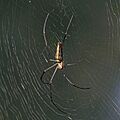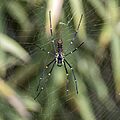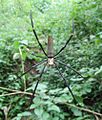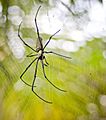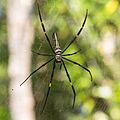Northern golden orb weaver facts for kids
Quick facts for kids Northern golden orb weaver |
|
|---|---|
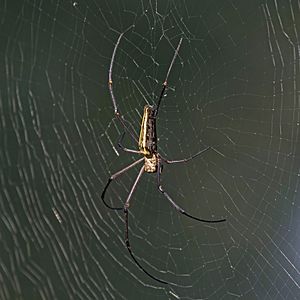 |
|
| Dorsal side | |
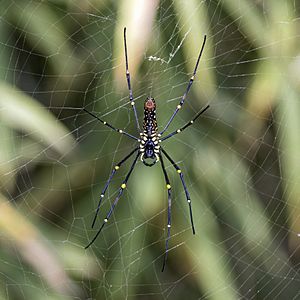 |
|
| Ventral side both Madhya Pradesh, India |
|
| Scientific classification | |
| Synonyms | |
|
Aranea longipes |
The Nephila pilipes is a fascinating spider often called the northern golden orb weaver or giant golden orb weaver. You can find these amazing creatures all over East Asia, Southeast Asia, and Oceania. They commonly live in old and secondary forests, as well as gardens.
These spiders are known for their huge size difference between males and females. Female Nephila pilipes are much larger, with bodies growing 30–50 mm long. Their legs can make them look up to 20 cm across! Males are tiny in comparison, only 5–6 mm long. This makes Nephila pilipes the second largest orb-weaving spider known, after the recently found Nephila komaci.
Young female Nephila pilipes have special dense, hairy brushes on their first, second, and fourth pairs of legs. These brushes disappear as the spider grows up.
The golden web of N. pilipes stands vertically and has a fine, irregular pattern. It's not perfectly even, with the center usually closer to the top. Unlike some other spiders, N. pilipes females don't hang their egg sacs in the web. Instead, they dig a small pit in the ground and cover it with plant bits or soil to protect their eggs.
Contents
What Does the Giant Golden Orb Weaver Look Like?
N. pilipes spiders show a huge difference in size between males and females. Females are giants compared to the tiny males. This is one of the biggest size differences between males and females seen in any land animal! This happens because bigger females can lay more eggs. Female N. pilipes put a lot of effort into their babies, from making eggs to building their large webs.
Female Spiders
Female N. pilipes usually have a body size of 30–50 mm. Their head and chest area (called the cephalothorax) is about 15 mm long and 10 mm wide. The main body part (the abdomen) is about 30 mm long and 15 mm wide. It's mostly a dark yellow-brown color with yellow stripes.
The top of their body (the tergum) is usually black or brown and covered with thick hairs. Both rows of their eyes stick out towards the back. The underside of their chest (the plastron) is mostly black and brown. Their legs are very long, black, and yellow. These bright colors might help them catch prey that can see colors well.
Male Spiders
Male N. pilipes are much smaller, typically 5 mm to 6.5 mm long. Their head and chest area is about 2.5 mm long and 2 mm wide. Their abdomen is about 4 mm long and 1.5 mm wide. Their front eyes are bigger than their back eyes.
Males have light brown legs with some hairs. The top of their head (the carapace) is yellow with very few hairs.
How to Tell Them Apart From Other Spiders
It's easy to tell N. pilipes apart from its close relatives. Unlike the Nephila clavata, N. pilipes has a horn-like bump on its back. Also, it has a pair of yellow stripes on the back of its abdomen, which the Nephila laurinae does not have.
Where Do They Live?
N. pilipes spiders like damp places that don't get direct sunlight. You can find them in many countries, including Japan, China, Vietnam, Cambodia, Taiwan, Malaysia, Singapore, Myanmar, Indonesia, Thailand, Laos, Philippines, Sri Lanka, India, Nepal, Papua New Guinea, and Australia.
In Australia, most N. pilipes live in rainforests in the north and east. These areas are humid, and the plants provide shade. Generally, these spiders live near coastlines where there's plenty of rain. However, they have also been found far from the coast in drier areas.
N. pilipes can survive in many different climates, like coastal areas, Mediterranean regions, and tropical savannas. They build their webs in bushes and trees, near water, and even on buildings.
To stay cool in the sun, Nephila spiders have a special trick. When it gets hot (around 32 °C), they change the angle of their body to the sun. They point their abdomen towards the sun but keep their head and chest parallel to the web. If it gets even hotter, they line up their whole body with the sun's direction to reduce how much heat they absorb. If the temperature goes above 40 °C, they will leave their web.
Unlike some other spiders, N. pilipes are active all year round. Adult females lay eggs continuously, and adult males stay in the population longer than females.
What Do They Eat?
Nephila spiders are picky eaters and only prey on certain insects. They will even remove some insects from their webs if they don't like them, such as wasps or ants that taste bad. Because Nephila spiders are so big, they can catch insects of many sizes, from tiny 2 mm bugs to ones even bigger than themselves!
They use different ways to catch prey depending on its size. Small prey are caught and removed from the web right away. For larger prey, they inject venom and wait for the prey to stop moving.
Young Nephila spiders (spiderlings) hunt differently than adults. When they are young, they hunt together on a shared web. Once they grow up, they build their own webs. Nephila spiders also store extra food. They wrap extra prey in silk and keep it in the middle of their web. This silk wrapping helps keep the prey from drying out. Having a food stash helps them survive when there isn't much food around.
Some N. pilipes can even change how much ultraviolet (UV) light their body stripes reflect to attract prey that are drawn to UV light. The yellow and black stripes on their legs and body reflect UV light, making them more visible to flying insects. The contrast makes them look like a food source to insects, rather than a dangerous spider.
Amazing Web Structures
Web Type
Generally, Nephila spiders build webs that are not perfectly even. Their silk looks yellow, which is why they are called golden orb-weavers. Adult Nephila webs are usually about 0.5–1.0 meters wide. But when many females gather, their webs can become even larger! The center of the web is usually at the top, and most prey get caught in the lower part of the web.
How They Build Their Webs
The web built by N. pilipes has stretchy silk in the middle. This stretchy part helps absorb the energy of insects flying into the web. Around this stretchy part, there are strong structures that hold the web to trees or other objects.
N. pilipes can change what their silk is made of depending on what they eat and their surroundings. One study found that when N. pilipes eat flies (small, airborne prey), their silk becomes more stretchy, and the web's mesh becomes smaller. When they eat crickets (large, strong prey), their silk becomes stiffer. Researchers also found that N. pilipes can change the tiny building blocks (amino acids) of their silk to fit their needs.
Spider silk is incredibly strong, even stronger than most materials humans make! Because of its amazing properties, the silk from Nephila spiders is very interesting to scientists who study materials science. However, when scientists try to make this silk in a lab, it often isn't as good as the natural silk.
Web Damage and Repair
Just like other spiders, their webs can get damaged by birds or small animals. If a web is only partly damaged, it usually takes N. pilipes about 10–60 minutes to fix it. But if the damage is really bad, the spider will eat its old web and build a brand new one in a nearby spot.
Spider Mating and Reproduction
Finding a Mate
Once male spiders grow up, they leave their own webs to search for females. They look for the right chemical signals and web features to find a mate. It seems that N. pilipes don't use airborne scents (pheromones) to find each other for mating.
Mating Interactions
In nature, male and female spiders often have different goals when it comes to mating. Males want to fertilize as many females as possible. Females, however, are more careful and often only want to mate with males that seem strong and healthy.
Female spiders can be quite aggressive during mating. They might shake the web or chase the male away when he gets close. They can kick the male if he touches their leg, or violently shake their body if the male climbs on their back. They might even suddenly stop mating by kicking the male off.
However, N. pilipes have a less aggressive mating process than some of their relatives, and females rarely eat the males after mating (called sexual cannibalism). Males have developed a clever trick called mate binding to avoid female resistance and being eaten. Males can put silk soaked with special chemicals onto the female's body. This silk calms the female's senses, making her less aggressive. This way, males can mate more safely and with more females.
Laying Eggs
Other Nephila spiders lay their eggs near their webs and cover them with a thick layer of silk. They then attach the egg mass firmly to leaves or tree branches. The eggs are always found under leaves or in shaded spots to protect them from direct sunlight.
But N. pilipes is different from all other Nephila species! Female N. pilipes lay their eggs in small pits dug in the ground. This helps keep the eggs safe from predators and parasites.
Who Are Their Enemies?
Not many studies have looked into what preys on N. pilipes. The main enemy of N. pilipes in nature is birds. Birds have learned to fly by and snatch the spiders without getting stuck in their sticky webs. It's rare for N. pilipes to be attacked by parasites like wasps.
To avoid being eaten by birds, female Nephila spiders often build their webs close to other females or other orb-weaving spiders. This creates a large web system that can help shield them from birds.
Do They Bite Humans?
Bites from N. pilipes to humans are very rare. Their bites are likely similar to those from other orb-weaving spiders. These bites can cause symptoms like muscle pain, a feeling of tightness, and exaggerated reflexes. Treatments like calcium gluconate can help relieve the pain. Antiserum treatment can also help a person recover faster.
Traveling by Air: Ballooning
Ballooning is a common way for young spiders to travel. After they hatch, spiderlings can use the wind to spread out to new areas. This helps them avoid crowded habitats and competing for food.
Research in labs has shown that N. pilipes spiderlings will start ballooning when the wind speed reaches about 3.17 m/s. However, in the wild, many things can affect ballooning, such as wind direction, humidity, temperature, and air pressure.
Ballooning can also be a social behavior. When most spiderlings in a group start to balloon, some spiderlings might sense that the population is getting smaller and choose to stay in their original spot. Ballooning helps explain why N. pilipes are found in so many places and how they sometimes reach islands.
Can Humans Eat Them?
The Raglai people in Vietnam's Bình Thuận Province eat N. pilipes after roasting them. They consider them a healthy food source. In fact, N. pilipes can even help local people avoid hunger if they run out of other food.
Images for kids
-
Mating pair in Kaeng Krachan National Park, Thailand
-
Northern Queensland, Australia
-
In Yangmingshan National Park, Taiwan
-
Bantul, Indonesia
-
Kitulgala, Sri Lanka


